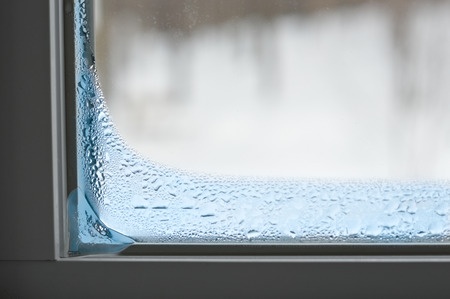It seems like with our varying cold climate here in Calgary that window condensation in the winter is purely unavoidable. When you do notice a bit of condensation forming in the winter, you have a few options: cross your fingers that damage will not be done, accept your fate and let the damage happen or find out the source of the problem and actually do something about it. We want to see everyone take action this winter.
 Condensation on your windows can take a toll in a number of different ways. It can peel paint around the edges of your windows, it can lead to staining of the insides of windows between double panes, and can also lead to damage to the window frames – think moisture that leads to wood weakness or rotting. All in all, condensation can lead to needing new windows much sooner than you were planning on replacing them.
Condensation on your windows can take a toll in a number of different ways. It can peel paint around the edges of your windows, it can lead to staining of the insides of windows between double panes, and can also lead to damage to the window frames – think moisture that leads to wood weakness or rotting. All in all, condensation can lead to needing new windows much sooner than you were planning on replacing them.
So what can you do to reduce or even eliminate condensation this winter? First, you want to reduce any excess humidity inside of your home. Some simple solutions to do this would be to use exhaust fans in the kitchen while you are cooking and in the bathroom while you are bathing. If you are planning on buying a clothes dryer, make sure that it is not ventless. When you are running the washer and dryer, they add moisture to the air; when you are running them, open a window slightly or be sure to utilize the ventilation system to get this excess moisture out of the house. Drying clothes on a rack and not in the dryer also adds very large amounts of moisture to the house.
It’s good to keep a certain level of moisture in the air at your home, especially since humid air carries heat better and will help your furnace run more efficiently. The easiest option is to turn down the humidifier settings, reducing the overall moisture but still retaining a level of humidity to help keep warm air moving. However, if your home doesn’t have a humidifier or if you still have high humidity levels, a dehumidifier can help you pull some of the excess moisture from the air.
One last consideration is temperature. As the temperature falls lower and lower, the humidity level in your home should too. Colder temperatures outside makes your window temperatures drop, making condensation possible even at lower humidity levels. For instance, condensation can form much more rapidly in a home – even with low humidity – when it’s -30 C outside versus when it’s hovering around 0 C.
Most of these factors that help to control window condensation in the winter are habits that can be controlled and easily changed. Save the windows on your home by making a few easy adjustments, and help keep your windows in good condition all year long.


Good!
Thank you for this well-written article! We have also struggled with condensation living in an old-school camper van.
We wanted to share a few extra tips we have learned to help fight off extra moisture:
https://bodhiwanders.com/2021/11/dealing-with-condensation-in-a-van-or-boat/
I’m writing from Ottawa – my low-e/argon gas-filled pvc framed windows are now 20 years old. It’s currently -19C with a -28C wind chill. There’s a small amount of condendation accumulation at the bottoms of the inside glazing at the glass/frame junction. My question is do such windows deteriorate with age and should I be looking at replacing them. Thanks for any thoughts you my have.